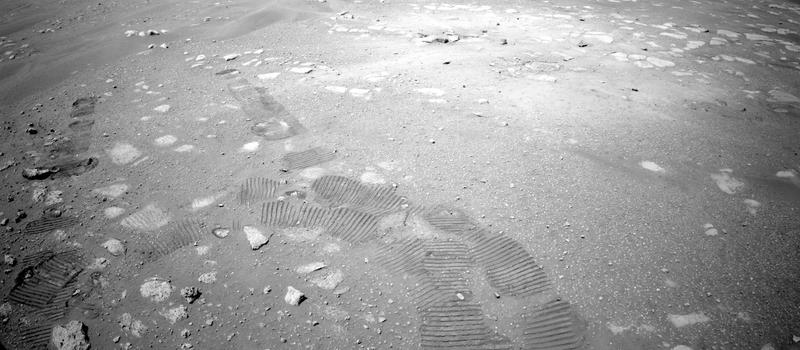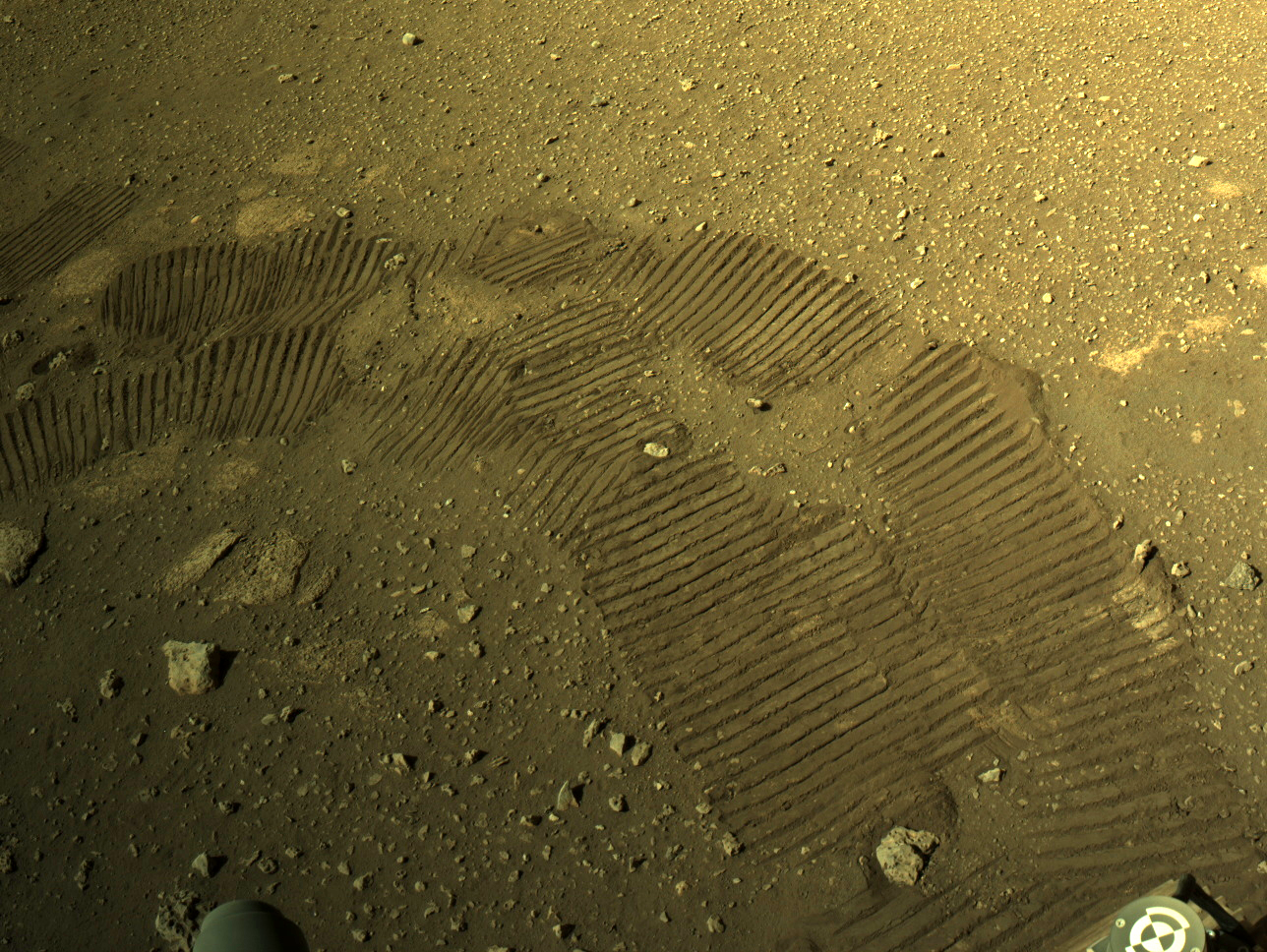NASA's Perseverance rover takes its first test drive on Mars
Percy is on the move!
NASA's Perseverance rover has taken its first test drive on Mars, the agency announced Friday (March 5).
Perseverance, a car-sized rover that landed successfully on the Red Planet Feb. 18, just made its first short drive on Thursday, NASA officials said. The rover moved a total of 21.3 feet (6.5 meters) across the Martian terrain on a drive that took about 33 minutes, during which Perseverance moved forward, turned in place and backed up. The rover drives with a top speed of .01 miles per hour (.016 kilometers).
"Our first drive went incredibly well," NASA's Anais Zarifian, a Perseverance mobility test bed engineer at the Jet Propulsion Laboratory in Pasadena, California. Zarifian added that the rover "works beautifully, we were so excited."
"This is really just the beginning," Zarifian said.
During the briefing, mission team members also announced that they are naming Perseverance's landing site in Jezero Crater "Octavia E. Butler Landing" after the famed science fiction author; the first science fiction author to receive the MacArthur Fellowship.
In photos: NASA's Perseverance rover on Mars


Join our forums here to discuss the Perseverance rover on Mars. What do you hope finds?
While Perseverance has the same body design as NASA's Curiosity rover, which landed on Mars in 2012, improvements to its mobility system mean that it can drive for much longer in the same amount of time. While the two rovers have the same top speed, Perseverance's new cameras and improved navigation software allow it to think about where it's going while in motion.
So, while Curiosity had to essentially stop to think, Perseverance can "walk and chew gum at the same time," Zarifian said. This allows the rover to cover more ground more quickly, despite having the same "speed."
Get the Space.com Newsletter
Breaking space news, the latest updates on rocket launches, skywatching events and more!

To prepare for this first drive, mission team members had the rover turn its wheels in place, making sure they were displaying their full range of motion and were ready for the short trip. NASA shared a short video clip on the rover's Twitter feed of one of the rover's wheels turning in the Martian surface as part of this preparation.
"A quick test of my steering, and things are looking good as I get ready to roll. My team and I are keen to get moving. One step at a time," Perseverance team members wrote on Twitter.
A quick test of my steering, and things are looking good as I get ready to roll. My team and I are keen to get moving. One step at a time. pic.twitter.com/XSYfT158AQMarch 5, 2021
"So striking to see rover tracks that begin from nothing. @NASAPersevere is on the move!" Perseverance rover operator and Earth & planetary science Ph.D. candidate Erin Gibbons said on Twitter alongside a photo of the tracks the rover made on the Martian surface.
So striking to see rover tracks that begin from nothing. @NASAPersevere is on the move! pic.twitter.com/zHnxXtK1uLMarch 5, 2021
This first drive comes as Perseverance checks a handful of other Martian "firsts" off its list, which all seem to be going very well.
"Perseverance has been doing an exceptional job in her first two weeks on the red planet," Robert Hogg, the rover's deputy mission manager at JPL, said during the news briefing today.
Among these milestones are the rover's first arm stretch — an important first step to getting its robotic arm, a critical asset for sampling and scientific observation, moving — and the deployment of wind sensors — instruments that are part of the rover's weather station, which will monitor air temperature, humidity, radiation, dust and wind.
Rover controllers also recently checked in with the craft's RIMFAX (Radar Imager for Mars' Subsurface Experiment) and MOXIE (Mars Oxygen In-Situ Resource Utilization Experiment) instruments. The rover has also continued to send back images of its new, Martian environment back to Earth.
"We are seeing all kinds of textures and rocks that are around Perseverance's landing site," Perseverance deputy project scientist Katie Stack Morgan of JPL told Space.com during the briefing when asked about what mission scientists are already gleaning the rover's images.
"But we are only just getting our instruments checked out, so these other instruments are really important for us to put together a model for how these rocks form and what their significance might be ... we landed in a very interesting area where we are trying to figure out the origin of these rocks," Morgan added.
Perseverance is the crown jewel of NASA's Mars 2020 mission, and will spend its time on the Red Planet searching for concrete signs of ancient life, along with collecting scientific data to do things like study the planet's complex climate; the rover will also be completing technology experiments like with Ingenuity, the Mars helicopter.
Email Chelsea Gohd at cgohd@space.com or follow her on Twitter @chelsea_gohd. Follow us on Twitter @Spacedotcom and on Facebook.
Join our Space Forums to keep talking space on the latest missions, night sky and more! And if you have a news tip, correction or comment, let us know at: community@space.com.

Chelsea “Foxanne” Gohd joined Space.com in 2018 and is now a Senior Writer, writing about everything from climate change to planetary science and human spaceflight in both articles and on-camera in videos. With a degree in Public Health and biological sciences, Chelsea has written and worked for institutions including the American Museum of Natural History, Scientific American, Discover Magazine Blog, Astronomy Magazine and Live Science. When not writing, editing or filming something space-y, Chelsea "Foxanne" Gohd is writing music and performing as Foxanne, even launching a song to space in 2021 with Inspiration4. You can follow her on Twitter @chelsea_gohd and @foxannemusic.









